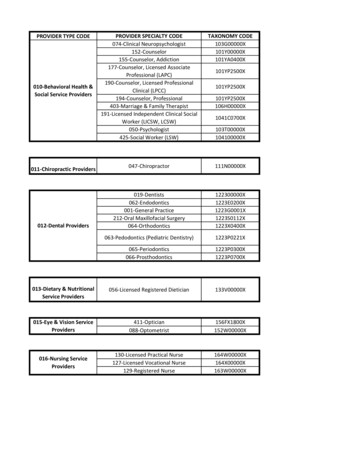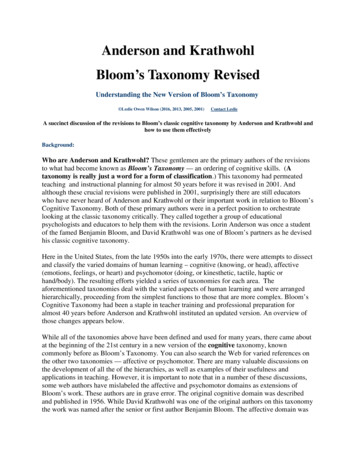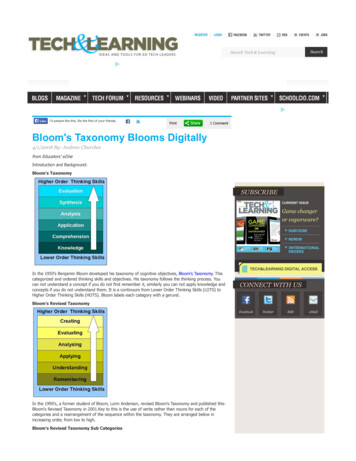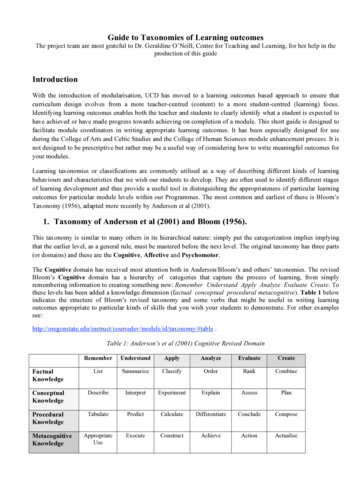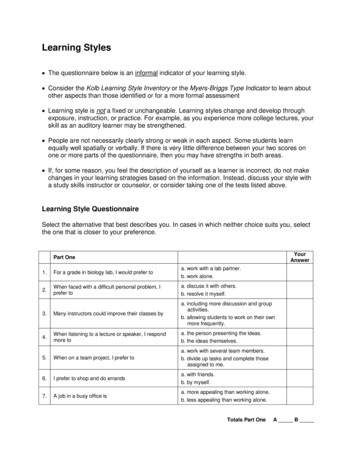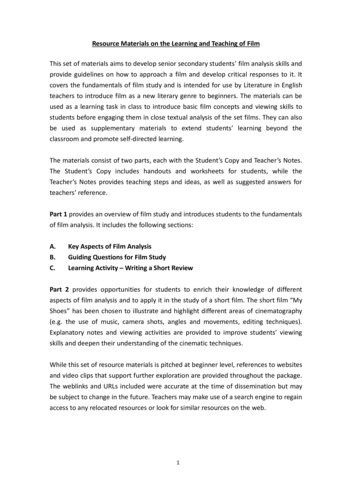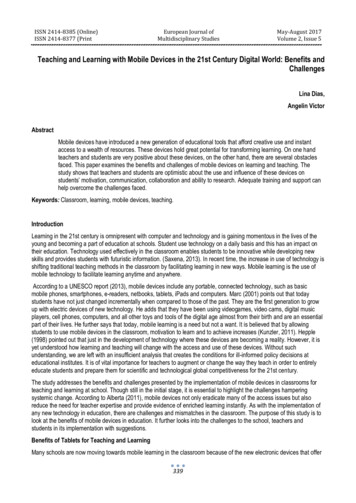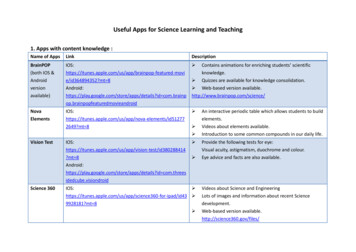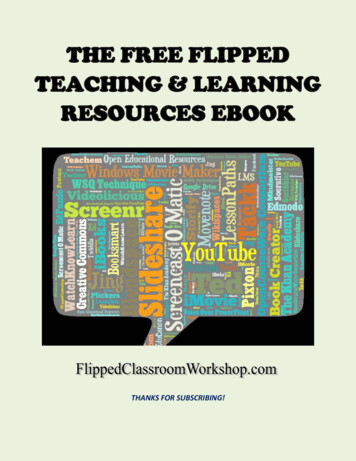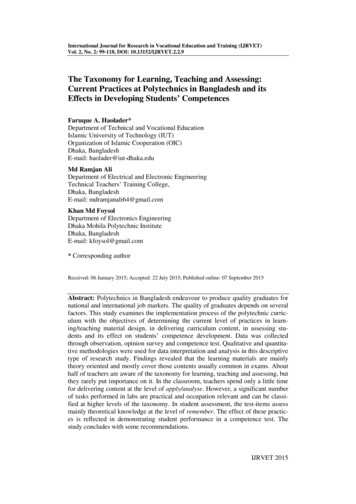
Transcription
International Journal for Research in Vocational Education and Training (IJRVET)Vol. 2, No. 2: 99-118, DOI: 10.13152/IJRVET.2.2.9The Taxonomy for Learning, Teaching and Assessing:Current Practices at Polytechnics in Bangladesh and itsEffects in Developing Students’ CompetencesFaruque A. Haolader*Department of Technical and Vocational EducationIslamic University of Technology (IUT)Organization of Islamic Cooperation (OIC)Dhaka, BangladeshE-mail: haolader@iut-dhaka.eduMd Ramjan AliDepartment of Electrical and Electronic EngineeringTechnical Teachers’ Training College,Dhaka, BangladeshE-mail: mdramjanali64@gmail.comKhan Md FoysolDepartment of Electronics EngineeringDhaka Mohila Polytechnic InstituteDhaka, BangladeshE-mail: kfoysol@gmail.com* Corresponding authorReceived: 06 January 2015; Accepted: 22 July 2015; Published online: 07 September 2015Abstract: Polytechnics in Bangladesh endeavour to produce quality graduates fornational and international job markets. The quality of graduates depends on severalfactors. This study examines the implementation process of the polytechnic curriculum with the objectives of determining the current level of practices in learning/teaching material design, in delivering curriculum content, in assessing students and its effect on students’ competence development. Data was collectedthrough observation, opinion survey and competence test. Qualitative and quantitative methodologies were used for data interpretation and analysis in this descriptivetype of research study. Findings revealed that the learning materials are mainlytheory oriented and mostly cover those contents usually common in exams. Abouthalf of teachers are aware of the taxonomy for learning, teaching and assessing, butthey rarely put importance on it. In the classroom, teachers spend only a little timefor delivering content at the level of apply/analyse. However, a significant numberof tasks performed in labs are practical and occupation relevant and can be classified at higher levels of the taxonomy. In student assessment, the test-items assessmainly theoretical knowledge at the level of remember. The effect of these practices is reflected in demonstrating student performance in a competence test. Thestudy concludes with some recommendations.IJRVET 2015
100F. A. Haolader, M. R. Ali & K. M. FoysolKeywords: Taxonomy, Competence, Learning, Teaching, Assessment, Technicaland Vocational Education and Training, TVET, Diploma in Engineering, Curriculum Implementation, Polytechnics, BangladeshBibliographical notes:Dr Faruque A. Haolader is an associate professor at the Islamic University ofTechnology (IUT), a subsidiary organ of the Organisation of Islamic Cooperation(OIC). He has a doctoral degree in Technical and Vocational Education fromStuttgart, Germany, a master’s degree in Vocational and Adult Education for International Development Work from Dresden, Germany, a master’s degree in Engineering (Electronics & IT) from England, and a bachelor degree in Electrical andElectronic Engineering from Bangladesh. His research interests focus on teachinglearning in teacher's training and curriculum development (TVET), TVET curricula,didactic media, educational technology, competence modelling and measurement.MD Ramjan Ali is an assistant professor at the Department of Electrical and Electronic Engineering at Technical Teachers Training College, Bangladesh. He has abachelor’s and a masters’ degree both in electrical and electronic engineering andmore than 25 years of teaching experience. His research interests focus on teaching-learning in TVET and curriculum.Khan Md. Foysol is an Instructor at Dhaka Mahila Polytechnic Institute in Bangladesh. He has more than eight years of teaching experience in the field of electronics technology. He has bachelor’s of science and master’s of science degrees bothin Technical Education with specialization in Electrical and Electronic Engineeringfrom the Islamic University of Technology (IUT) in Dhaka. Mr Khan’s Researchinterest is in TVET.IJRVET 2015
The Taxonomy for Learning, Teaching and Assessing1101IntroductionThe intended results at the output and outcome stages of systematic learningteaching process in technical and vocational education and training (TVET) areworkplace-relevant qualification and competences, work-related social competences and general individual characteristics of learners (e.g. Rauner et al., 2007; KMK,2007; Bader, 2004; Ott, 1998, w.r.t Lempert, 1986). Therefore, TVET curriculaobjectives are set to provide the trainees/students with the expertise in techniquesor technologies (the domain-specific competences) relevant to an occupation, including other constituents of occupational competences (Boreham and Fischer,2009; Tippelt and Amoros, 2003; Ellström, 1997). The curricula content should bemore relevant, practical and useful than general education (e.g. Dare, 2006; Plank,2001; Finch and Crunkilton, 1999), and the implementation process should enablestudents to learn/achieve these competences/learning outcomes, and finally they(intended competences/learning outcomes) should be checked through assessmentand evaluation systems.However, the development of students’ occupational competences dependsnot only on a well-designed curriculum but also on many other factors, such asinstructional quality, content delivery, student assessment approaches (curriculumimplementation) and the quality of learning/teaching materials, among others, (e.g.Geißel, 2008; Fretwell, Lewis and Deij, 2001; Helmke and Weinert, 1997; Biggs,1995). In the process of student performance assessment, the assessment procedureand performance measuring tools/instruments play an important role in developingstudents’ competences (e.g. Bieg and Mittag, 2009; Nickolaus, 2008; Geißel, 2008;Hopkins, 1998).It should be mentioned that TVET students become involved in learning witha good level of motivation both because they are stimulated intellectually and because they can readily see how their learning applies to their lives (Stone and Aliaga, 2003). Therefore, the TVET curriculum and its implementation should focusnot just on remembering or reproducing but also on applying (transferring) or evengenerating new knowledge to specific situations that demand higher level cognitiveprocess/ability (e.g. Ebel and Frisbie, 2009; Hopkins, 1998).Some research studies have identified problems in TVET institutions in Bangladesh and barriers to the development of TVET graduates’ competence. Kashemet al., (2011) and Oxtoby (1997), for example, state that the current TVET curricula, particularly the Polytechnic curricula of the Diploma-in-Engineering Programme, is too theoretical oriented, and a huge mismatch exists between the graduates’ competence and the competences in-use at the workplace, and therefore,they are unable to earn a considerable level of employers’ satisfaction. Some otherstudies have identified other barriers to quality TVET in Bangladesh, such as inadequate professional preparation of teachers in teaching methods, practical skills andindustrial experience; a lack of academic supervision; a lack of teacher and institutional accountability; insufficient and unsuitable textbooks and lab equipment; alack of government initiative and coordination among different levels of education(primary, secondary, tertiary) and among institutions; a lack of teacher-studentcommunication; improper licensing; insufficient student keys and basic competencies at the entry-level; a lack of self-learning facilities at training institutes (forexample, using ICT); a lack of modern teaching aids and inadequate attention toresearch, among others. (e.g. TVET Reform Project, 2015; Haolader and Paul,IJRVET 2015
102F. A. Haolader, M. R. Ali & K. M. Foysol2013; Elbushari and Aktaruzzaman, 2012; Shears, 2011; ADB, 2008; WB, 2007;Khanam and Shamsuddoha, 2003).Irrespective of the above-mentioned problems/barriers, a body of researchstudies (e.g. Anderson and Krathwohl, 2001; Hopkins, 1998; Savery and Duffy,1996; Gronlund, 1993; Bloom, et al., 1956) suggests that while designing and organising learning tasks, learning-teaching materials, instructions in classrooms/labsand the assessment tools for student performance measurement, tasks at differentcomplexity levels of the taxonomy should be checked in terms of educational objectives and other factors, which support developing basic and occupation-relevantcompetences. Since these factors, along with appropriate learning-teaching models,strategies, and so on, contribute to the development of students’ competence andshould be practiced during the learning-teaching process if desired outcomes are tobe achieved.However, so far as it is known, only a few (or no) research studies have beendone which focused on the learning-teaching materials, instructional design andcontent delivery methods usually used in polytechnic education in Bangladesh interms of occupational relevance, knowledge categories and complexity levels ofthe tasks. Therefore, in this study, the researchers investigate the level of practicingthe taxonomy for learning, teaching and assessing, more specifically, in learning/teaching materials, in curriculum content delivery in classrooms and labs, andin student assessment at polytechnics in Bangladesh. Furthermore, to determine theeffects of these factors (or practices), we measure the cognitive competence levelof graduating (final year) polytechnic students. Finally, we make some recommendations as well.In the following sub-sections, we describe briefly the taxonomy of educational objectives, polytechnic education, the Diploma-in-Engineering Programme, andthe occupational profile of diploma engineers.1.1 The Taxonomy of Educational ObjectivesIn the 1950s, following the 1948 Convention of the American Psychological Association, Bloom and his co-workers established a hierarchy of educational objectives,which is generally referred to as Bloom's Taxonomy (Bloom et al., 1956). Otherapproaches of classification of learning content and outcomes are, for example, theNew Taxonomy of Educational Objectives developed by Marzano and Kendall(2007), the Structure of Observed Learning Outcomes (SOLO) taxonomy developed by Biggs and Collis (1982), are gaining attention, too. However, Bloom’sTaxonomy is still one of the most widely used ways of organizing learning contentand student learning outcomes (levels of expertise) and is considered as a “foundational element” in education (Shane, 1981). Therefore, this study considers thelatter one (Bloom’s Taxonomy).Bloom's Taxonomy, which deals with the cognitive domain (knowledge,comprehension and the development of intellectual attitudes and skills), refers tothe classification of educational objectives (at different levels – ranging from thesimplest behaviour to the most complex) that educators set for learners (learningobjectives). A goal of this taxonomy is to motivate teachers/educators to focus ondifferent levels of this taxonomy, creating a more holistic form of education(Bloom, et al., 1956). According to Bloom (1956), there are six levels in the taxonomy, moving through the lowest order processes to the highest: knowledge, comprehension, application, analysis, evaluation and synthesis. Anderson and Krathwohl (2001) revised the original/classic Bloom’s Taxonomy to incorporate advancIJRVET 2015
The Taxonomy for Learning, Teaching and Assessing103es in learning theory and practice since its inception, and offered the followingtwo-dimensional framework to describe learning objectives:ConceptualCognitive Process Dimension Remember Understand ApplyAnalyzeRemember Understand Apply Facts AnalyzeFactsFactsusing Facts,Concepts,PrinciplesRemember Understand ApplyandConcepts/ Concepts/Concepts/ProceduresPrinciplePrinciples PrincipleEvaluateEvaluateusing Facts,Concept,PrincipleandProceduresCreateCreate ocedureRemember UnderstandMetacog. zeEvaluateCreateusing Meta. using Meta. using r-Remember UnderstandProcedures ProceduresMetacognitiveKnowledge Dimension FactualTable 1: Cognitive Process and Knowledge DimensionKnowledgeNotes: Source: Dalton, 2003, Heer, 2012, with reference to Anderson and Krathwohl, 2001.This two-dimensional framework distinguishes among the types of knowledgebeing learned (e.g. fact, concept/principle, procedure, m) and the type of cognitiveprocess being employed (remember, understand, apply, analyze, evaluate, or create). In the left-most three columns, there is a strong correlation between the levelof cognitive process and the type of knowledge content. For example, learners areoften expected to remember facts, understand concepts/principles and apply procedures. However, creating learning objectives in the other cells is also possible,including apply facts and concepts. In each of the relatively more complex cognitive processes (analyze, evaluate and create), multiple types of knowledge contentare generally employed. Often, another set of terms (knowledge, skill and ability)are used to characterize these objectives, as shown along the bottom of the framework (Dalton, 2003).A curriculum, particularly the TVET curriculum, includes content of differentlevels of learning objectives (Bloom et al., 1956; Anderson and Krathwohl, 2001;Marzano and Kendall, 2007). Therefore, learning/teaching activities and assessment should focus on achieving these learning objectives.1.2 Polytechnic Education and the Diploma-in-Engineering ProgrammeThe Diploma-in-Engineering programme of Bangladesh Technical EducationBoard (BTEB) is implemented through Polytechnic Institutes or similar TVETInstitutions and leads to a diploma level qualification for mid-level technicians/supervisors/managers/diploma engineers. It corresponds to Bangladesh National Technical and Vocational Qualification (NTVQ) Level 6 (NTVQ, 2012;BTEB, 2014) and can be referenced to the Upper Secondary Technical/VocationalLevel 3 and Non-Tertiary Level 4 qualification with the provision of direct accessto the job market and to the tertiary level of higher education (ISCED, 2011;ISCED, 1997). Students who acquire lower secondary qualification with a mini-IJRVET 2015
104F. A. Haolader, M. R. Ali & K. M. Foysolmum of 10 years of schooling (ISCED Level 2) can enrol to this diploma programme. The curriculum of this diploma programme is developed by the BTEB.The duration of this programme is four years and is divided into eight semesters,including one Internship Semester at Industries. Unlike other forms of competencybased TVET curricula or training standards, for example, Germany’s learning-areabased framework (Lernfeld) curriculum (KMK, 2008; KMK, 2007), the diplomacurriculum in Bangladesh is traditionally organized according to subject. Veryrecently, (from 2011 to 2014) the curriculum of this programme has been reviewedto address the changing requirements of the job market. The curriculum has about50 taught courses (subjects), having a total of 162 credits in different subject categories, such as occupational/domain-specific subjects (90 credits, 56%); crossoccupational subjects (19 credit, 11%); mathematics and natural sciences (24 credits, 15%); arts, humanities and social sciences (13 credits, 8%); business competence and environmental studies (10 credits, 6%); and industrial attachment (sixcredits, 4%). These subjects are delivered in theory and practical/lab classes in aschool-based setting with 12 weeks of industrial placement training in the last semester.At present, 49 public and 385 private polytechnic institutes (includingNGO/not-for-profit) offer the four-year Diploma-in-Engineering Programme. In2014, the total actual enrolment in public institute was 22,916 (including 3,899female; 17.01%) in double shifts (morning and afternoon sessions), and it was29,742 (including 1,925 females; 6.47%) in private institutes. It should be notedthat the actual enrolment drifted slightly downwards from the actual enrolment inthe previous year (2013), where the figures were 23,463 (including 3,338 females;14.22%) and 34,332 (including 2,439 females; 7.10%) in public and private institutions, respectively (source: BTEB official current data, as of 6 December 2014).1.3 Occupational Profile of Diploma EngineersThe typical fields of activities of a diploma engineer (in Electronics Technology)may be, for example, production automation, process automation, network automation, traffic management systems, building security and automation systems, radioand television production, service industries and other electronic systems. Graduates can also be employed in hospitals, infrastructure facilities and industrial plants.Other fields are ICT devices, medical devices, automotive systems, systems components, sensors, actuators, micro systems, EMS (Electronic Manufacturing Services), and measurement and testing technology (Haolader, 2010).Duties and responsibilities may include producing, putting into operation andmaintaining components and devices and integrating, putting into operation, monitoring and maintaining electronic systems and automation solutions. Diploma engineers also provide technical and organizational services, conceive new ideas andinstall safety, monitoring and surveillance techniques. They install data networks,fire and burglar alarm systems, access control systems, video monitoring systems,and telecommunication installation; they also operate these installations. Theydevelop, install, configure and parameterize software and test IT systems. Moreover, they work independently, take economic and environmental concerns intoconsideration, and observe the relevant technical regulations and safety rules andcoordinate their work with the preceding and following activities. They often workas part of a team [ibid.]. Vocationally organised work is becoming multidimensional, and hence the qualification requirements (the competences) in today’sworkplace are also multidimensional (e.g. Winther and Achtenhagen, 2009;IJRVET 2015
The Taxonomy for Learning, Teaching and Assessing105Hensge et al., 2008; KMK, 2007; Bader and Müller, 2002; Sloane and Dilger,2005).2Scope and Objectives of the StudyWithin the TVET sub-sector of Bangladesh, this empirical study was delimited topolytechnic education, particularly the study focused on the implementation process of the Diploma-in-Engineering (Electronics Technology) curriculum (learning-teaching and assessing) and the learning-teaching materials usually used bypolytechnic students and teachers in Bangladesh. The aim of study is to improvethe effectiveness of learning/teaching in achieving students’ learning outcomes.The findings of this study would be used in designing learning materials, planninginstructions and developing assessment tools which will contribute to more effective implementation of the diploma level curricula in Bangladesh.The specific objectives of this research work were to: examine how the content of the learning-teaching materials for polytechniceducation in Bangladesh is designed in terms of learning objectives; determine the level of practicing the educational taxonomy for learning,teaching, and assessing with respect to the curricular objectives, and determine how the above mentioned factors influence the development ofstudents’ competence by assessing the level of students’ cognitive competences that they achieved throughout their study;3MethodologyThis is a descriptive type of research study which employed both qualitative andquantitative investigations to address the research objectives. Firstly, we observedwhat type (English and/or Bengali medium) of learning-teaching materials areusually used by teachers and students in polytechnic education. Authors’ long experience in working with the polytechnic education system helped a lot in this process of data gathering. For examining how the content of learning-teaching materials is designed, the qualitative methodology was used, whereby we studied themostly used course related to learning-teaching materials (books/handouts, etc.).Secondly, for determining the level of awareness and practices of the educationaltaxonomy during teaching, an observation technique was used, whereby we directly observed teachers teaching in the classroom and labs. To aid the observation, atool was developed for surveying teachers’ opinions on the quality of learningteaching materials and the level of awareness and practices of the educational taxonomy. The questionnaire consisted of statements (where the participants expressed their opinions on a 5-point Likert-type scale), item-selection and open typeitems. Further data was collected through studying the assessment tools (questionpapers of semester final exams from the last three to five years) used for polytechnic students’ assessment. Thirdly, students’ cognitive competences were quantitatively measured through a separate self-designed competence test. The competencetest consisted of 16 application-oriented tasks covering the core area of the occupation of an electronics technician, such as electronics, micro-controllers, relays/contactors, sensors, information technology, industrial communication, uninterruptible power supply (UPS), electrical motors/drives, machine safety and smallcontrollers/PLCs. The tasks were structured consisting of several test items thatdemand skills and knowledge at various levels of the cognitive process andIJRVET 2015
106F. A. Haolader, M. R. Ali & K. M. Foysolknowledge dimensions, which would be required in practicing a student’s futureoccupation. For example, Task 1 was an electronic control circuit with galvanicisolation mechanism using relays, contactors and a two-input digital NOR-logicmodule. The schematic diagram of the circuit was provided. Such types of electronic circuits are often used in electronic controls where the control circuit (lowvoltage side) must be separated from the main power circuit (relatively high voltage side). Students were asked to determine the outputs and hence the state (on/off)of the main power circuit for given possible input logic levels at the control circuit.Task 2 was regarding a motor control circuit using magnetic contactors. Studentswere asked what the consequence would be due to a wire breakage between twogiven terminals. Task 3, 4 and 16 were constructed using PLC and sensors with abasic application. Supplementary information, diagrams and so on were providedto assist them in answering the questions related to these tasks. In Task 9, studentswere asked to complete a given incomplete circuit diagram that connects the chipMAX232 to a serial port of a microcontroller and to a nine-pin sub-D connector.For this task, the required datasheet for the chip was supplied. Similarly, the rest ofthe 16 tasks were relevant to one or more core learning fields, as mentioned above.The complete set of tasks can be supplied when requested. The tasks were didactically simplified. Thus, based on the design, the test items should have measuredstudents’ competencies at the cognitive process level of remember, understand,and apply or in terms of the major types (factual, conceptual and procedural) ofknowledge, according to Anderson and Krathwohl’s (2001) revision of the originalBloom’s Taxonomy (Bloom, et al., 1956). Furthermore, during the test design, theauthors considered the fact that the knowledge about constituent elements of (upcoming) learning fields is usually the largest contributor to the explanation of thevariance of the learning success, or to the predicted performance of one’s futuredevelopment (Knöll, 2007; Nickolaus et al., 2006; Nickolaus et al., 2005). Theitem-wise validity of the test was examined by experienced teachers and experts inthe field of electronic technology. They (experts/teachers) assessed each of the testitems on four given criteria and marked them on a 5-point answer scale, from 1(very low) to 5 (very high). These criteria were: 1) workplace relevancy (application oriented) for the occupation of diploma engineer (electronic technology), 2)whether the test items were within the syllabus (content-related validity), 3) thedegree of complexity, and 4) the comprehensibility. Based on the experts’/teachers’opinions, almost all the tasks included in the test were ratified as practical and relevant, where about 75% of the tasks were graded with nearly 4 or above (highlyrelevant), and only a few tasks were graded with 3.5 on the 5-point scale. According to teachers’ opinions, all tasks were within the syllabus. However, a few teachers who validated the test acknowledged that some course contents related to a fewnumber of test items/tasks were taught only about 25% to 50% and were mainlyaddressed theoretically, not practised in lab classes. In terms of “the degree ofcomplexity”, all tasks were rated with points between 2.0 (easy) and 4.0 (complex).The comprehensibility levels of all the tasks were between 3.6 and 4.6 on the 5point scale, while 1.0 means “very low” and 5.0 means “very high”. A pilot testwas carried out with a small group of students. On the basis of the pilot test resultsand experts’ opinions, some tasks were redefined, rearranged or explained for better comprehensibility. The time duration of the test was closely observed during thepiloting phase and was fixed to a predetermined 50-minute test time. To determinethe reliability of the test, the Cronbach coefficient, α (alpha) and the SpearmanBrown coefficient were calculated and found to be 0.858 and 0.890, respectively;IJRVET 2015
The Taxonomy for Learning, Teaching and Assessing107the calculations were made in consideration of all 16 tasks in a group. After classifying the test items into three separate categories (remember, understand and apply), we calculated the reliability coefficients, as shown in Table 3.1.Table 3.1: The Results of the Reliability TestTypes of TestTotalCronbach coefficient0.858Spearman-Brown coefficient 0.890Remember nience sampling was used, whereby 50 teachers from six selected polytechnic institutes participated in this survey/interview, and a total of 150 graduatingstudents from the same six selected polytechnic institutes in Dhaka and nearbycities in Bangladesh took the test. These institutions represent the country in thesense that they are among the biggest and oldest institutions in Bangladesh. Thetotal number of teachers and students of the Department of Electronics Technologyand the sample size at each of these institutes are given in Table 3.2.Table 3.2: The number of teachers and students at the participating eacher (#Female)TotalSample12 (5)10 (3)17 (12)17 (12)7 (2)5 (1)5 (1)5 (1)7 (2)7(2)9 (1)6 (1)57(23)50 (20)# Student (Female)TotalSample80 (20)25 (6)80 (80)25 (25)80 (10)25 (04)40 (10)25 (3)40 (7)25 (2)40 (5)25 (2)360 (132)150 (42)Out of the total 50 teachers, 38 (76%) have over five years of teaching experience,and the remaining 12 teachers (24%) have teaching experience between two andfive years. Seven teachers have diploma qualification, 24 have a bachelor’s degree,and five have a master’s degree in a relevant field of technical education or electrical and electronic engineering.The selection was based on the presence of students at the test time. We administered the test in the presence of a class teacher. At the beginning, studentswere motivated to take the test by explaining the purpose of it. For example, wementioned that though this test they would be able to compare their competencelevel with others in the participating polytechnics, as there would be a commonmerit list among all the students. Also, they would know how well they are prepared for their future workplace. Furthermore, the presence of a mix of simple andrelatively complex tasks helped the students to stay motivated and to maintain theirconcentration throughout the test. The quantitative data was analysed using SPSSstatistics.IJRVET 2015
1084F. A. Haolader, M. R. Ali & K. M. FoysolFindings4.1 Practicing the Taxonomy in Designing Learning/Teaching MaterialsThe learning/teaching materials, which are usually used by polytechnic studentsand teachers, were studied to examine how their content was organised and presented. It was found that a majority of these learning materials (books and modules) for technical (domain specific) subjects focus mostly on facts, definitions,working principles and descriptions of devices, circuits, and so on. The content thatcan be categorised as higher–level cognitive processes often included synthetic/theoretical tasks and did not simulate real workplace situations. However, someof the Bengali medium textbooks explained the conceptual knowledge nicely. But,in several cases, it was explained using (high level) mathematics, ignoring the conception of didactic reduction methodologies. For example, in a text book writtenfor the “Basic Electronics” course (subject code 6811), ripple factor, efficiency andtransformer utilization factor (TUF) (defined as the ration of power delivered to theload and AC rating of the transformer secondary) are calculated using calculus.The recommended reference books for (applied) mathematics are the same booksas general higher education. In these math books, it is not clearly explained howthe math knowledge can be applied/transferred to solve technical (occupational)tasks/problems relevant to occupational activities in the field of electronics technology. Furthermore, the authors found that a majority of teachers and studentsmainly use Bengali medium books/lecture notes. These books/lecture notes areoften theory oriented, and learning tasks are not didactically designed particularlyfor mid-level engineering technology education. Different authors of these translated Bengali medium-level books often us
the taxonomy for learning, teaching and assessing, more specifically, in learn-ing/teaching materials, in curriculum content delivery in classrooms and labs, and in student assessment at polytechnics in Bangladesh. Furthermore, to determine the effects of these factors

